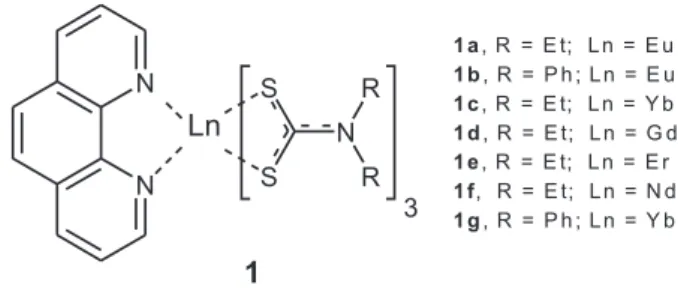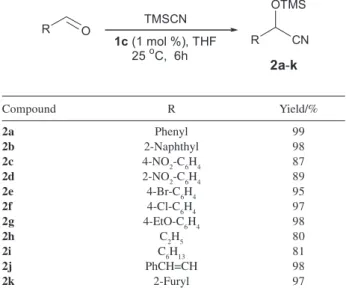J. Braz. Chem. Soc., Vol. 17, No. 5, 829-831, 2006. Printed in Brazil - ©2006 Sociedade Brasileira de Química 0103 - 5053 $6.00+0.00
C
o
m
m
u
ni
c
a
ti
o
n
*e-mail: julianadqf@yahoo.com.br
Lanthanide Dithiocarbamate Complexes: Efficient Catalysts for the
Cyanosilylation of Aldehydes
Juliana A.Vale,* Wagner M. Faustino, Paulo H. Menezes and Gilberto F. de Sá
Departamento de Química Fundamental, Universidade Federal de Pernambuco, 50740-540 Recife-PE, Brazil
Uma nova classe de complexos ditiocarbamato de lantanídeo foi usada para promover a cianosililação de aldeídos com elevados rendimentos à temperatura ambiente. Esta é a primeira aplicação de ditiocarbamato de lantanídeo atuando como ácido de Lewis.
A new class of lanthanide dithiocarbamate complexes was used to promote the cyanosilylation of aldehydes at high yields at room temperature. This represents the first application of lanthanide dithiocarbamate acting as Lewis acid.
Keywords: lanthanide dithiocarbamate, cyanosilylation, Lewis acid, cyanohydrins
Introduction
The addition of trimethylsilyl cyanide (TMSCN) to carbonyl compounds is one of the most effective preparation
methods of cyanohydrins.1 Upon reaction, cyanohydrins or
cyano trimethylsilyl ethers can be transformed into the
corresponding α-hydroxyacids,2 α-hydroxyketones,3 α
-amino acids,4 and β-amino alcohols,5 which are not only
important building blocks in the synthesis of natural products but also in the field of biology and pharmaceuticals.
Many different catalysts have been developed for this
reaction.6 A range of chemical catalyst classes are available
for such reaction, including chiral and achiral Lewis acids7
and bases8 and transition metal complexes.9 In recent years,
several lanthanide compounds such as triflates10 and
organometallic derivatives11 have been used as catalysts
for the addition of TMSCN to carbonyl compounds. Additionally, optically active catalysts based on lanthanides for the asymmetric synthesis of cyanohydrins
have been reported in the literature.12
We describe herein a high yield and at room temperature methodology for cyanation of aldehydes by
the use of lanthanide dithiocarbamate complexes 1, an
inexpensive catalyst (Figure 1).
The use of complexes (1)13 has two advantages if
compared to other systems based lanthanide compounds:
(i) chemical stability and easy manipulation in anhydrous
form; (ii) high solubility in organic solvents.
Results and Discussion
Since our initial studies focused on the development of an optimum set of reaction conditions, the addition of TMSCN to benzaldehyde was examined in order to optimize the reaction conditions. In this way, benzaldehyde (1.25 mmol) and TMSCN (2.5 mmol) were treated at room temperature with different lanthanide catalysts (Table 1).
As it can be seen on Table 1, the use of 1 mol% of
lanthanide catalyst (1a-g) for the addition of TMSCN
to benzaldehyde in THF, gave the corresponding
trimethyl silyl ethers cyanohydrin (2a) at room
temperature with excellent yields. Ytterbium catalyst
(1c) proved to be the most effective (Table 1, entry 7).
In the absence of catalyst, the reaction proceeded in longer reaction times (6 days at room temperature) to give product in 45% yield (Table 1, entry 13). Lengthy
reaction time was observed when 1c was replaced by
Yb(OTf)3 (Table 1, entry 12).
830 Lanthanide Dithiocarbamate Complexes J. Braz. Chem. Soc.
It was also observed that the replacements of ethyl group
in lanthanide dithiocarbamate complexes (1a and 1c, Table
1, entries 3 and 7) by the phenyl group (1b and 1g, Table 1, entries 2 and 11) have small influence in the reaction yield.
The influence and the nature of the solvent are noteworthy. When the reaction was performed using ethanol as solvent no product was observed (Table 1, entry 6). The use of acetonitrile or toluene gave the desired product in lower yields (Table 1, entries 4 and 5). On the other hand, the use of dichloromethane or tetrahydrofuran greatly enhanced the product yield.
Thus, the optimal conditions for the cyanation reaction
were found to be the use of Ytterbium catalyst 1c
(1 mol%) and THF as solvent at room temperature for 6 hours. Moreover, the methodology was extended to other aldehydes. The results are summarized on Table 2.
The electronic effects of the aldehyde were briefly studied. All substituted aldehydes proved to have similar reactivities giving the desired products in high yields. Similar reactivity was observed for both aldehydes containing activating or deactivating groups (Table 2,
Compounds 2b-2g). Acid sensitive aldehydes such as
furfuraldehyde and cinnamaldehyde gave products without
decomposition (Table 2, compounds 2j and 2k). When n
-propanal and n-heptanal were used as aldehyde source,
the desired cyanohydrins were obtained in good yield and
short reaction time (Table 2, compounds 2h and 2i).
Experimental
General methods
All products are known and were identified by comparison of their spectral data and physical properties with authentic sample or with those reported in the
literature.11,14-16 The progress of reaction was monitored
by thin layer chromatography on silica gel. All yields refer to isolated products.
1H NMR and 13C NMR spectra were recorded on a
Varian Unity Plus (300 MHz) spectrometer in CDCl3 with
TMS as an internal standard. Mass spectra were obtained on a Shimadzu GC-MS QP5050A instrument operating at 70 EV.
General procedure for lanthanide complexes (1) promoted addition TMSCN to aldehydes
To a solution of ytterbium diethyldithiocarbamate
complex, 1c (10 mg, 0.0125 mmol) in THF (3 mL)
under argon at room temperature was added aldehyde (1.25 mmol) followed by TMSCN (2.5 mmol). The resulting solution was stirred at room temperature for
6 hours before quenching with H2O (3 mL). The mixture
was diluted with dichloromethane (5 mL) and the organic phase was separated, dried over anhydrous magnesium sulfate and concentrated in vacuum. The crude product was purified by flash chromatography
eluting with n-hexane / ethyl acetate (8:2) to give the
cianohydrin silyl ether.
Table 2. Addition of TMSCN to aldehydes catalyzed by ytterbium
di-ethyl-dithiocarbamate complexa (1c)
Compound R Yield/%
2a Phenyl 99
2b 2-Naphthyl 98
2c 4-NO2-C6H4 87
2d 2-NO2-C6H4 89
2e 4-Br-C6H4 95
2f 4-Cl-C6H4 97
2g 4-EtO-C6H4 98
2h C2H5 80
2i C6H13 81
2j PhCH=CH 98
2k 2-Furyl 97
aConditions: RCHO: TMSCN (1:2).
Table 1. Addition of TMSCN to benzaldehyde catalyzed by lanthanide
complexes 1 in different reaction conditions
Entry Lanthanide Solvent timea/ h Yield b /% complex
1 1a CH2Cl2 10 98
2 1b CH2Cl2 10 87
3 1a THF 9 98
4 1a CH3CN 10 70
5 1a PhCH3 10 65
6 1a CH3CH2OH 10
-7 1c THF 6 99
8 1d THF 10 97
9 1e THF 8 92
10 1f THF 11 94
11 1g THF 6 86
12 Yb(OTf)3c THF 20 93
13 - CH2Cl2 6 days 45
831 Vale et al.
Vol. 17, No. 5, 2006
Conclusions
In conclusion, we have demonstrated the effectiveness of the use of new lanthanide complexes as Lewis acids in the addition of TMSCN to various aldehydes. The present methodology provides the first example that utilizes the lanthanide dithiocarbamate complexes acting as Lewis acid catalysts in the cyanosilylation of aldehydes to give the corresponding cyanohydrins in good yields and short reaction times if compared with other methodologies already described for lanthanide compounds.
Acknowledgments
We gratefully acknowledge the financial support from CNPq, IMMC-CNPq, FACEPE and CAPES.
References
1. Gregory, R. J. H.; Chem. Rev. 1999, 99, 3649; Duthaler, R. O.; Hafner, A.; Chem. Rev. 1992, 92, 807; North, M.; Tetrahedron: Asymmetry 2003, 14, 147; Pisoni, D. S.; Silva, D. B.; Schenato, R. A.; Ceschi, M. A.; J. Braz. Chem. Soc. 2004, 15, 652. 2. Effenberger, F.; Horsch, B.; Weingart, F.; Ziegler, T.; Kühner,
S.; Tetrahedron Lett. 1991, 32, 2605; Effenberger, F.; Heid, S.; Tetrahedron: Asymmetry 1995, 6, 2945.
3. Krepski, L. R.; Jensen, K. M.; Heilmann, S. M.; Rasmussen, J. K.; Synthesis 1986, 301.
4. Zandbergen, P.; Brussee, J.; Van der Gen, A.; Kruse, C. G.; Tetrahedron: Asymmetry 1992, 3, 769.
5. Ziegler, T.; Horsch, B.; Effenberger, F.; Synthesis 1990, 575; Tanaka, K.; Mori, A.; Inoue, S.; J. Org. Chem. 1990, 55, 181; Kanerva, L. T.; Acta Chem. Scand. 1996, 50, 234.
6. Azizi, N.; Saidi, M. R.; J. Organomet. Chem. 2003, 688, 283; Jafari, A. A.; Firouzabadi, H.; Iranpoor, N.; J. Organomet. Chem. 2005, 690, 1556; Bandini, M.; Cozzi, P.; Melchiorre, P.; Ronochi, A. V.; Tetrahedron Lett. 2001, 42, 3041; Curini, M.; Epifano, F.; Marcotullio, M. C.; Rosati, O.; Rossi, M.; Synlett 2002, 315; Kim, S. S.; Kim, D. W.; Rajagopal, G.; Synthesis 2004, 213.
7. Evans, D. A.; Truesdale, L. K.; Tetrahedron Lett. 1973, 14, 4929; Loh, T. P.; Xu, K. C.; Ho, D. S. C.; Sim, K. Y. Synlett
1998, 1169; Bolm, C.; Muller, P.; Harms, K.; Acta Chem. Scand.
1996, 50, 305; Bolm, C.; Muller, P.; Tetrahedron Lett. 1995, 36, 1625; Pan, W.; Feng, X.; Gong, L.; Hu, W.; Li, Z.; Mi, A.; Jiang, Y.; Synlett 1996, 337; Belokon, Y.; Flego, M.; Ikonnikov, N.; Moscalenko, M.; North, M.; Orizu, C.; Tararov, V.; Tasinazzo, M.; J. Chem. Soc., Perkin Trans 1 1997, 1293; Tararov, V. I.; Hibbs, D. E.; Hursthouse, M. B.; Ikonnikov, N. S.; Malik, K. M. A.; North, M.; Orizu, C.; Belokon, Y. N.; J. Chem. Soc., Chem. Commun. 1998, 387; Kobayashi, S.; Tsuchiya, Y.; Mukaiyama, T.; Chem. Lett. 1991, 541; Iovel, I.; Popelis, Y.; Fleisher, M.; Lukevics, E.; Tetrahedron: Asymmetry
1997, 8, 1279; Corey, E. J.; Wang, Z.; Tetrahedron Lett. 1993, 34, 4001.
8. Fetterly, B.; Verkade, J. G.; Tetrahedron Lett. 2005, 46, 8061; Guo-Fu, Z.; J. Mol. Catal. A.: Chem. 1998, 132, 1381; Tian, S.-K.; Deng, L.; J. Am. Chem. Soc. 2001, 123, 6195; Tian, S.-K.; Hong, R.; Deng, L.; J. Am. Chem. Soc. 2003, 125, 9900; Tian, S.-K.; Chen, Y.; Hang, J.; Tang, L.; Mcdaid, P.; Deng, L.; Acc. Chem. Res. 2004, 37, 621.
9. Li, Y.; He, B.; Qin, B.; Feng, X.; Zhang, G.; J. Org. Chem.
2004, 69, 7910.
10. Yang, Y.; Wang, D.; Synlett 1997, 1379.
11. Mei, L; Zhu, M. H.; Synth. Commun. 2005, 35, 2615. 12. Aspinall, H. C.; Bickey, J. F.; Greeves, N.; Kelly, R. V.; Smith,
P. M.; Organometallics 2005, 24, 3458; Qian, C. T.; Zhu, C. J.; Huang, T. S.; J. Chem. Soc., Perkin Trans 1 1998, 2131; Utimoto, K.; Takai, T.; Kasuga, Y.; Matsubara, S.; Appl. Organomet. Chem. 1995, 9, 413; Yang, Y.; Wang, D.; Synlett
1997, 1379.
13. Faustino, W. M.; Malta, O. L.; Teotonio, E. E. S.; Brito, H. F.; Simas, A. M.; De Sá, G. F.; J. Phys. Chem. A. 2006, 110, 2510. 14. Mei, L.; J. Mol. Catal. A.: Chem. 2005,227, 183.
15. Kim, S. S.; Rajagopal, G.; Song, D. H.; J. Organomet. Chem.
2004,689, 1734.
16. Shen Y.; Feng X.; Li Y.; Zhang G.; Jiang Y.; Tetrahedron 2003, 59, 5667.
Received: June 9, 2006

